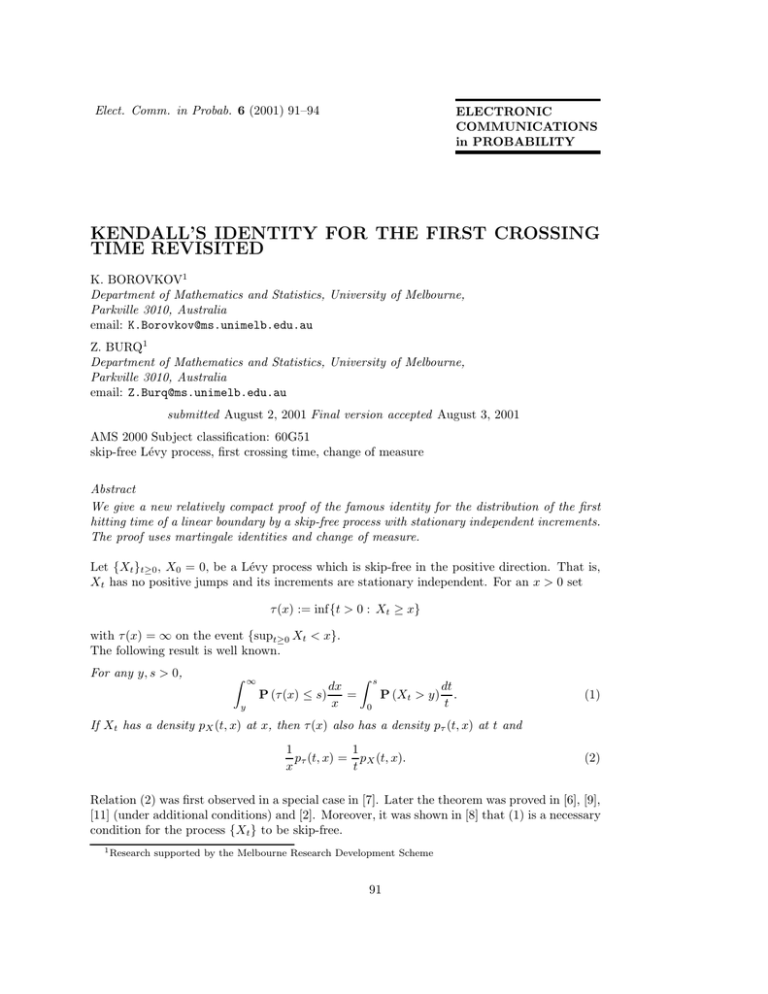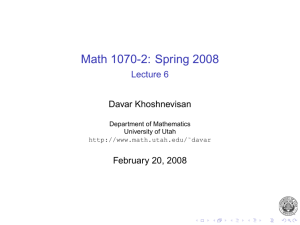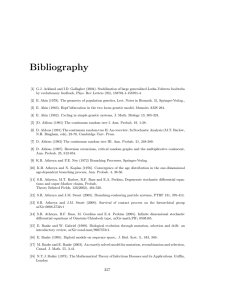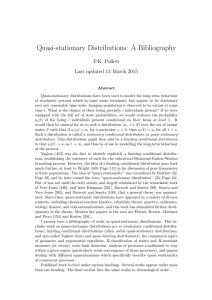KENDALL’S IDENTITY FOR THE FIRST CROSSING TIME REVISITED
advertisement

Elect. Comm. in Probab. 6 (2001) 91–94
ELECTRONIC
COMMUNICATIONS
in PROBABILITY
KENDALL’S IDENTITY FOR THE FIRST CROSSING
TIME REVISITED
K. BOROVKOV1
Department of Mathematics and Statistics, University of Melbourne,
Parkville 3010, Australia
email: K.Borovkov@ms.unimelb.edu.au
Z. BURQ1
Department of Mathematics and Statistics, University of Melbourne,
Parkville 3010, Australia
email: Z.Burq@ms.unimelb.edu.au
submitted August 2, 2001 Final version accepted August 3, 2001
AMS 2000 Subject classification: 60G51
skip-free Lévy process, first crossing time, change of measure
Abstract
We give a new relatively compact proof of the famous identity for the distribution of the first
hitting time of a linear boundary by a skip-free process with stationary independent increments.
The proof uses martingale identities and change of measure.
Let {Xt }t≥0 , X0 = 0, be a Lévy process which is skip-free in the positive direction. That is,
Xt has no positive jumps and its increments are stationary independent. For an x > 0 set
τ (x) := inf{t > 0 : Xt ≥ x}
with τ (x) = ∞ on the event {supt≥0 Xt < x}.
The following result is well known.
For any y, s > 0,
Z
y
∞
dx
=
P (τ (x) ≤ s)
x
Z
s
0
P (Xt > y)
dt
.
t
(1)
If Xt has a density pX (t, x) at x, then τ (x) also has a density pτ (t, x) at t and
1
1
pτ (t, x) = pX (t, x).
x
t
(2)
Relation (2) was first observed in a special case in [7]. Later the theorem was proved in [6], [9],
[11] (under additional conditions) and [2]. Moreover, it was shown in [8] that (1) is a necessary
condition for the process {Xt } to be skip-free.
1 Research
supported by the Melbourne Research Development Scheme
91
92
Electronic Communications in Probability
A discrete time (and, of course, space) analog of (2) is closely related to the classical ballot
problem and was first given (in a special case) as early as in 1711 by A. de Moivre. For
historical references and comments (and some generalizations) see e.g. [1] and Section 21 in
[10]. Some interesting extensions to the multidimensional case were given in [4].
Known proofs of the identities are either analytical (exploiting Laplace transforms in time
and their multiplicative structure) or are based on a limiting procedure and a combinatorial
argument (given, in particular in [5] and [10]) or factorization identities [3]. We present a new,
rather short and elegant (from our point of view) proof of the above result which uses (a)
martingale techniques to find the Laplace transform of the crossing time and then (b) change
of measure to find the desired representation for the distribution of the time in terms of the
distribution of Xt . To avoid a trivial situation, we assume that P (Xt > 0) > 0 for t > 0.
Proof. (i) Since there are no positive jumps in the process {Xt }, the m.g.f. ϕ(λ) := E eλX1 <
∞ for any λ ≥ 0 and is analytic on the positive half-line, and by independence of increments,
Mt := eλXt /ϕt (λ),
t ≥ 0,
is a martingale. Denote by Pλ the probability corresponding to the respective Cramér transform of the distribution of {Xt }, so that
Pλ (Xt ∈ dy) =
eλy
P (Xt ∈ dy)
ϕt (λ)
(3)
and the process {Xt } still remains a Lévy process under Pλ .
Next set λ0 := sup{λ ≥ 0 : ϕ(λ) = 1}. Clearly, 0 ≤ λ0 < ∞ always, and under Pλ the drift
in {Xt } is linear with the coefficient
mλ := E λ X1 =
ϕ0 (λ)
= (ln ϕ(λ))0 > 0
ϕ(λ)
for λ > λ0
(4)
(just recall the elementary fact that ln ϕ(λ) is convex and, when λ0 > 0, equal to 0 for both
λ = 0 and λ = λ0 ). Note also that, for λ > λ0 , one has ϕ(λ) > 1.
(ii) The last inequality, together with the obvious fact that Mt < eλx /ϕt (λ) on the event
{τ (x) > t}, implies that, as t → ∞, Mt → 0 on {τ (x) = ∞} (so that we can formally set
Mτ (x) = 0 on this event) and also E (Mt ; τ (x) > t) → 0. These relations ensure that the
optional stopping theorem holds:
1 = M0 = E Mτ (x) = eλx E e−µτ (x)
with µ := ln ϕ(λ)
(5)
(this can be shown e.g. by applying the theorem to the bounded stopping time τ (x) ∧ t and
then letting t → ∞). It is also clear that µ = µ(λ) is an increasing function mapping (λ0 , ∞)
onto (0, ∞) and hence has an inverse function λ = λ(µ), µ ∈ (0, ∞), with
1
ϕ(λ)
1
dλ
=
= 0
=
dµ
dµ/dλ
ϕ (λ)
mλ
(6)
from (4).
Now (5) is equivalent to E e−µτ (x) = e−λx , and differentiating this relation w.r.t. µ yields
Z ∞
x
dλ
=
e−µt t P (τ (x) ∈ dt) = xe−λx
.
(7)
dµ
mλ eλx
0
KENDALL’S IDENTITY FOR THE FIRST CROSSING TIME REVISITED
93
R∞
(iii) Next denote by TA = 0 1A (Xt ) dt the time spent by our process in the set A (i.e. the
sojourn time of A). We will make use of the following fact: for any 0 < a < ∞ and λ > λ0 ,
E λ T(0,a] =
a
.
mλ
(8)
To prove it, note that due to (4) and Wald’s identity one has for any a > 0
a = E λ Xτ (a) = mλ E λ τ (a).
(9)
Further, one can easily see that
(a)
τ (a) − T(−∞,0] ≤ T(0,a] ≤ τ (a) + T(−∞,0] ,
(10)
(a)
where TA denotes the time spent in A by the process {Xt+τ (a) − a}t≥0, which clearly has the
(a)
same distribution as {Xt }t≥0 , and hence T(−∞,0] and T(−∞,0] are identically distributed, too.
Moreover, for λ > λ0 , they have a finite expectation under Pλ :
Z ∞
Z ∞
1(−∞,0] (Xt ) dt ≤ E λ
e−λXt dt
Iλ := E λ T(−∞,0] = E λ
0
0
Z ∞ Z
Z ∞
Z ∞
eλy
dt
P (Xt ∈ dy) =
<∞
E λ e−λXt dt =
dt e−λy t
=
t
ϕ (λ)
ϕ (λ)
0
0
0
since ϕ(λ) > 1.
Now this and the RHS of (10) imply that E λ T(a,b] < ∞ for any finite interval (a, b] [the last
fact actually following from the well-known known recurrence-transience dichotomy for Lévy
processes as well]. Together with the obvious observation that, for any 0 < a < b < c < ∞,
T(a,b] + T(b,c] = T(a,c]
this means that a corresponding equality holds for the (finite) E λ -expectations of these variables, and hence we have
E λ T(a,b] = γ(b − a)
for some constant γ < ∞. But from (9) and (10) one gets
|E λ T(0,a] − a/mλ | ≤ Iλ ,
and letting here a → ∞ we immediately see that this constant γ must be equal to 1/mλ which
completes the proof of (8).
(iv) Note that equality (8) can be re-written as
Z ∞
Z ∞
a
= Eλ
1(0,a] (Xt ) dt =
Pλ (Xt ∈ (0, a]) dt
mλ
0
0
Z
Z ∞
Z ∞ Z
eλx
λx
−µt
P (Xt ∈ dx) =
dt
e P (Xt ∈ dx) dt .
e
=
t
(0,a] ϕ (λ)
(0,a]
0
0
Since the above holds for any a > 0, the expression in the brackets is (for any λ > λ0 ) nothing
else but a multiple of the Lebesgue measure: [· · ·] = m−1
λ dx for x ∈ (0, ∞), so that
Z ∞
dx
=
e−µt P (Xt ∈ dx) dt.
mλ eλx
0
94
Electronic Communications in Probability
Now dividing the LHS and RHS of (7) by x and integrating them w.r.t. dx over (y, ∞) we
get, using the above formula, that
Z ∞
Z ∞
Z
Z ∞
dx ∞ −µt
dx
P (τ (x) ∈ dt)
e t P (τ (x) ∈ dt) =
e−µt t
x 0
x
y
0
y
Z ∞
Z ∞
dx
=
e−µt P (Xt > y)dt.
=
mλ eλx
y
0
for any µ > 0. The equality of the Laplace transforms (in µ) implies that the measure
Z ∞
dx
P (τ (x) ∈ dt)
tL(dt) := t
x
y
has the density P (Xt > y), or, equivalently, that L(dt) has the density P (Xt > y)/t. And
this completes the proof since the desired identity (1) just represents that fact in terms of the
respective distribution functions.
References
[1] Barton, D. E., and Mallows, C. L. (1965) Some aspects of the random sequence. Ann.
Math. Statist. 36, 236–260.
[2] Borovkov, A. A. (1965) On the first passage time for a class of processes with independent
increments. Theor. Probab. Appl. 10, 360–364. [In Russian.]
[3] Borovkov, A. A. (1976) Stochastic processes in queueing theory. Springer: New York.
[4] Borovkov, K. A. (1995) On crossing times for multidimensional walks with skip-free components. J. Appl. Prob. 32, 991–1006.
[5] Feller, W. (1971) An introduction to probability theory and its applications. Vol. 2. 2nd edn.
Wiley: New York.
[6] Keilson, J. (1963) The first passage time density for homogeneous skip-free walks on the
continuum. Ann. Math. Statist. 34, 1003–1011.
[7] Kendall, D. G. (1957) Some problems in the theory of dams. J. Royal Stat. Soc. B, 19,
207–212.
[8] Rogozin, B. A. (1966) Distribution of certain functionals related to boundary value problems for processes with independent increments. Theor. Probab. Appl. 11, 161–169. [In
Russian.]
[9] Skorohod, A. V. (1964) Random processes with independent increments. Nauka: Moscow [In
Russian. English translation of the second Russian edition was published in 1991 (Kluwer:
Dordrecht).]
[10] Takács, L. (1967) Combinatorial methods in the theory of stochastic processes. Wiley:
New York.
[11] Zolotarev, V. M. (1964) The first passage time of a level and the behaviour at infinity
of a class of processes with independent increments. Theor. Probab. Appl. 9, 724–733. [In
Russian.]




